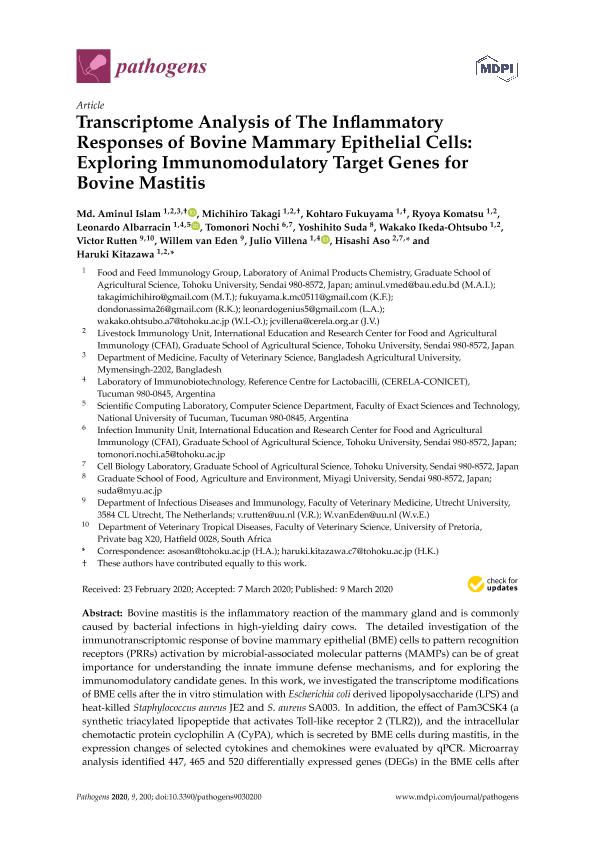Mostrar el registro sencillo del ítem
dc.contributor.author
Islam, Md Aminul

dc.contributor.author
Takagi, Michihiro
dc.contributor.author
Fukuyama, Kohtaro
dc.contributor.author
Komatsu, Ryoya
dc.contributor.author
Albarracín, Leonardo Miguel

dc.contributor.author
Nochi, Tomonori
dc.contributor.author
Suda, Yoshihito
dc.contributor.author
Ikeda Ohtsubo, Wakako

dc.contributor.author
Rutten, Victor
dc.contributor.author
van Eden, Willem
dc.contributor.author
Villena, Julio Cesar

dc.contributor.author
Aso, Hisashi

dc.contributor.author
Kitazawa, Haruki

dc.date.available
2021-03-03T11:25:48Z
dc.date.issued
2020-03
dc.identifier.citation
Islam, Md Aminul; Takagi, Michihiro; Fukuyama, Kohtaro; Komatsu, Ryoya; Albarracín, Leonardo Miguel; et al.; Transcriptome analysis of the inflammatory responses of bovine mammary epithelial cells: Exploring immunomodulatory target genes for bovine mastitis; Molecular Diversity Preservation International; Pathogens; 9; 3; 3-2020; 1-18; 200
dc.identifier.issn
2076-0817
dc.identifier.uri
http://hdl.handle.net/11336/127217
dc.description.abstract
Bovine mastitis is the inflammatory reaction of the mammary gland and is commonly caused by bacterial infections in high-yielding dairy cows. The detailed investigation of the immunotranscriptomic response of bovine mammary epithelial (BME) cells to pattern recognition receptors (PRRs) activation by microbial-associated molecular patterns (MAMPs) can be of great importance for understanding the innate immune defense mechanisms, and for exploring the immunomodulatory candidate genes. In this work, we investigated the transcriptome modifications of BME cells after the in vitro stimulation with Escherichia coli derived lipopolysaccharide (LPS) and heat-killed Staphylococcus aureus JE2 and S. aureus SA003. In addition, the effect of Pam3CSK4 (a synthetic triacylated lipopeptide that activates Toll-like receptor 2 (TLR2)), and the intracellular chemotactic protein cyclophilin A (CyPA), which is secreted by BME cells during mastitis, in the expression changes of selected cytokines and chemokines were evaluated by qPCR. Microarray analysis identified 447, 465 and 520 differentially expressed genes (DEGs) in the BME cells after LPS, S. aureus JE2 and S. aureus SA003 stimulation, respectively. A major differential response in the inflammatory gene expression was noticed between the stimulation of LPS and S. aureus strains. Unlike the S. aureus strains, LPS stimulation resulted in significant upregulation of CCL2, CXCL2, CXCL3, CXCL8, IL1α and IL1β, which were confirmed by qPCR analysis. Pam3CSK4 was not able to induce significant changes in the expression of cytokines and chemokines in challenged BME cells. The exogenous CyPA administration was able to upregulate CXCL2, CXCL3, CXCL8, IL1α and IL1β expression in BME cells indicating its ability to promote inflammation. The identification of transcriptional markers of mastitis specific for individual inflammatory factors such as LPS, Pam3CSK4 or CyPA, which can be evaluated in vitro in BME cells, may enable the development of novel diagnostics and/or immunomodulatory treatments, providing new tools for the effective management of mastitis in dairy cows. The results of this work are an advance in this regard.
dc.format
application/pdf
dc.language.iso
eng
dc.publisher
Molecular Diversity Preservation International

dc.rights
info:eu-repo/semantics/openAccess
dc.rights.uri
https://creativecommons.org/licenses/by/2.5/ar/
dc.subject
BOVINE MAMMARY EPITHELIAL CELLS
dc.subject
CYCLOPHILIN A
dc.subject
INFLAMMATION
dc.subject
LPS
dc.subject
TLR2
dc.subject
TLR4
dc.subject
TRANSCRIPTOME
dc.subject.classification
Inmunología

dc.subject.classification
Medicina Básica

dc.subject.classification
CIENCIAS MÉDICAS Y DE LA SALUD

dc.title
Transcriptome analysis of the inflammatory responses of bovine mammary epithelial cells: Exploring immunomodulatory target genes for bovine mastitis
dc.type
info:eu-repo/semantics/article
dc.type
info:ar-repo/semantics/artículo
dc.type
info:eu-repo/semantics/publishedVersion
dc.date.updated
2020-10-06T19:12:07Z
dc.identifier.eissn
2076-0817
dc.journal.volume
9
dc.journal.number
3
dc.journal.pagination
1-18; 200
dc.journal.pais
Suiza

dc.journal.ciudad
Basilea
dc.description.fil
Fil: Islam, Md Aminul. Bangladesh Agricultural University; Bangladesh. Tohoku University; Japón
dc.description.fil
Fil: Takagi, Michihiro. Tohoku University; Japón
dc.description.fil
Fil: Fukuyama, Kohtaro. Tohoku University; Japón
dc.description.fil
Fil: Komatsu, Ryoya. Tohoku University; Japón
dc.description.fil
Fil: Albarracín, Leonardo Miguel. Consejo Nacional de Investigaciones Científicas y Técnicas. Centro Científico Tecnológico Conicet - Tucumán. Centro de Referencia para Lactobacilos; Argentina. Universidad Nacional de Tucumán. Facultad de Ciencias Exactas y Tecnología; Argentina. Tohoku University; Japón
dc.description.fil
Fil: Nochi, Tomonori. Tohoku University; Japón
dc.description.fil
Fil: Suda, Yoshihito. Miyagi University; Japón
dc.description.fil
Fil: Ikeda Ohtsubo, Wakako. Tohoku University; Japón
dc.description.fil
Fil: Rutten, Victor. Utrecht University; Países Bajos. University of Pretoria; Sudáfrica
dc.description.fil
Fil: van Eden, Willem. Utrecht University; Países Bajos
dc.description.fil
Fil: Villena, Julio Cesar. Consejo Nacional de Investigaciones Científicas y Técnicas. Centro Científico Tecnológico Conicet - Tucumán. Centro de Referencia para Lactobacilos; Argentina. Tohoku University; Japón
dc.description.fil
Fil: Aso, Hisashi. Tohoku University; Japón
dc.description.fil
Fil: Kitazawa, Haruki. Tohoku University; Japón
dc.journal.title
Pathogens
dc.relation.alternativeid
info:eu-repo/semantics/altIdentifier/doi/http://dx.doi.org/10.3390/pathogens9030200
dc.relation.alternativeid
info:eu-repo/semantics/altIdentifier/url/https://www.mdpi.com/2076-0817/9/3/200
Archivos asociados
